ESG Factors and Valuation in Sustainable Finance Report
VerifiedAdded on 2020/04/21
|25
|6008
|100
Report
AI Summary
This report provides a comprehensive analysis of sustainable finance, focusing on Environmental, Social, and Governance (ESG) criteria and their impact on valuation. It examines ESG practices within the global telecommunications industry, highlighting metrics used by organizations like British Telecom and ETNO, and comparing their approaches to ESG priorities. The report delves into the risks associated with incorporating ESG factors in the valuation process, including subjectivity and potential for double accounting. Furthermore, it analyzes the financial models and performance of companies like Growthpoint Properties and Lok Capital, assessing metrics for measuring social and environmental impact and comparing fund performance against benchmarks. The report also includes a detailed discussion on the variance of ESG priorities and practices in the Telecom sector.

Running head: SUSTAINABLE FINANCE
Sustainable finance
Name of the Student:
Name of the University:
Author’s Note:
Sustainable finance
Name of the Student:
Name of the University:
Author’s Note:
Paraphrase This Document
Need a fresh take? Get an instant paraphrase of this document with our AI Paraphraser
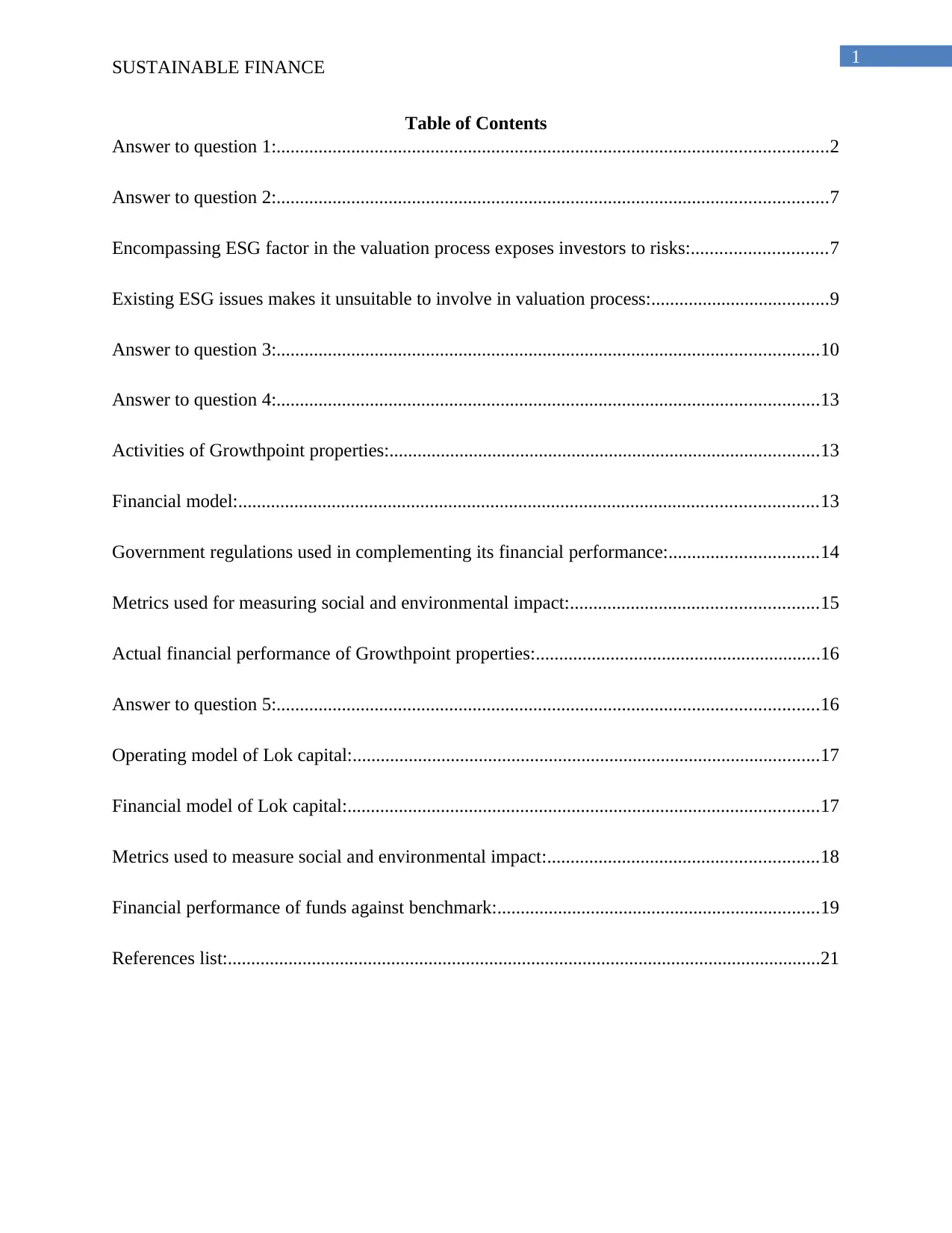
1
SUSTAINABLE FINANCE
Table of Contents
Answer to question 1:......................................................................................................................2
Answer to question 2:......................................................................................................................7
Encompassing ESG factor in the valuation process exposes investors to risks:.............................7
Existing ESG issues makes it unsuitable to involve in valuation process:......................................9
Answer to question 3:....................................................................................................................10
Answer to question 4:....................................................................................................................13
Activities of Growthpoint properties:............................................................................................13
Financial model:............................................................................................................................13
Government regulations used in complementing its financial performance:................................14
Metrics used for measuring social and environmental impact:.....................................................15
Actual financial performance of Growthpoint properties:.............................................................16
Answer to question 5:....................................................................................................................16
Operating model of Lok capital:....................................................................................................17
Financial model of Lok capital:.....................................................................................................17
Metrics used to measure social and environmental impact:..........................................................18
Financial performance of funds against benchmark:.....................................................................19
References list:...............................................................................................................................21
SUSTAINABLE FINANCE
Table of Contents
Answer to question 1:......................................................................................................................2
Answer to question 2:......................................................................................................................7
Encompassing ESG factor in the valuation process exposes investors to risks:.............................7
Existing ESG issues makes it unsuitable to involve in valuation process:......................................9
Answer to question 3:....................................................................................................................10
Answer to question 4:....................................................................................................................13
Activities of Growthpoint properties:............................................................................................13
Financial model:............................................................................................................................13
Government regulations used in complementing its financial performance:................................14
Metrics used for measuring social and environmental impact:.....................................................15
Actual financial performance of Growthpoint properties:.............................................................16
Answer to question 5:....................................................................................................................16
Operating model of Lok capital:....................................................................................................17
Financial model of Lok capital:.....................................................................................................17
Metrics used to measure social and environmental impact:..........................................................18
Financial performance of funds against benchmark:.....................................................................19
References list:...............................................................................................................................21
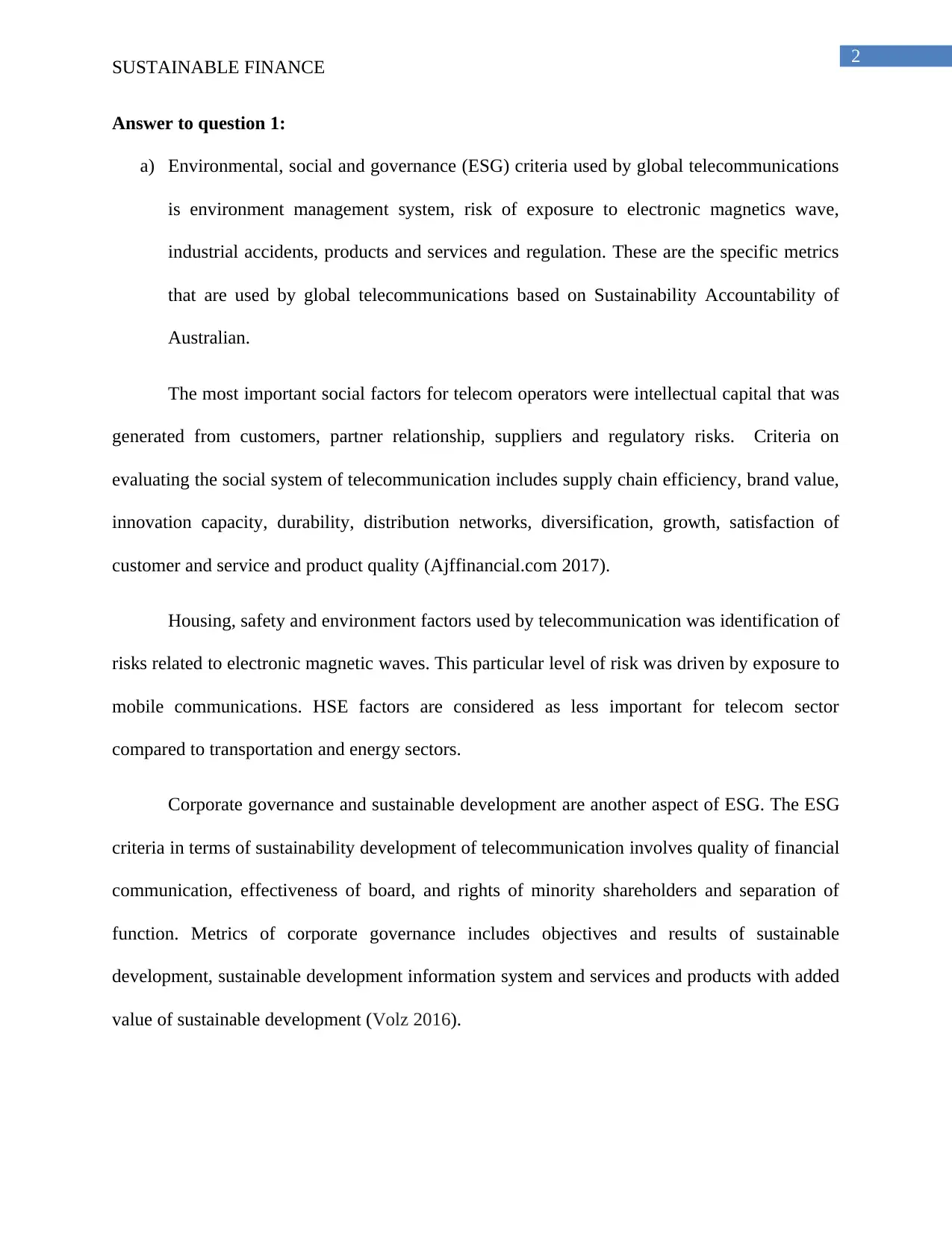
2
SUSTAINABLE FINANCE
Answer to question 1:
a) Environmental, social and governance (ESG) criteria used by global telecommunications
is environment management system, risk of exposure to electronic magnetics wave,
industrial accidents, products and services and regulation. These are the specific metrics
that are used by global telecommunications based on Sustainability Accountability of
Australian.
The most important social factors for telecom operators were intellectual capital that was
generated from customers, partner relationship, suppliers and regulatory risks. Criteria on
evaluating the social system of telecommunication includes supply chain efficiency, brand value,
innovation capacity, durability, distribution networks, diversification, growth, satisfaction of
customer and service and product quality (Ajffinancial.com 2017).
Housing, safety and environment factors used by telecommunication was identification of
risks related to electronic magnetic waves. This particular level of risk was driven by exposure to
mobile communications. HSE factors are considered as less important for telecom sector
compared to transportation and energy sectors.
Corporate governance and sustainable development are another aspect of ESG. The ESG
criteria in terms of sustainability development of telecommunication involves quality of financial
communication, effectiveness of board, and rights of minority shareholders and separation of
function. Metrics of corporate governance includes objectives and results of sustainable
development, sustainable development information system and services and products with added
value of sustainable development (Volz 2016).
SUSTAINABLE FINANCE
Answer to question 1:
a) Environmental, social and governance (ESG) criteria used by global telecommunications
is environment management system, risk of exposure to electronic magnetics wave,
industrial accidents, products and services and regulation. These are the specific metrics
that are used by global telecommunications based on Sustainability Accountability of
Australian.
The most important social factors for telecom operators were intellectual capital that was
generated from customers, partner relationship, suppliers and regulatory risks. Criteria on
evaluating the social system of telecommunication includes supply chain efficiency, brand value,
innovation capacity, durability, distribution networks, diversification, growth, satisfaction of
customer and service and product quality (Ajffinancial.com 2017).
Housing, safety and environment factors used by telecommunication was identification of
risks related to electronic magnetic waves. This particular level of risk was driven by exposure to
mobile communications. HSE factors are considered as less important for telecom sector
compared to transportation and energy sectors.
Corporate governance and sustainable development are another aspect of ESG. The ESG
criteria in terms of sustainability development of telecommunication involves quality of financial
communication, effectiveness of board, and rights of minority shareholders and separation of
function. Metrics of corporate governance includes objectives and results of sustainable
development, sustainable development information system and services and products with added
value of sustainable development (Volz 2016).
⊘ This is a preview!⊘
Do you want full access?
Subscribe today to unlock all pages.

Trusted by 1+ million students worldwide
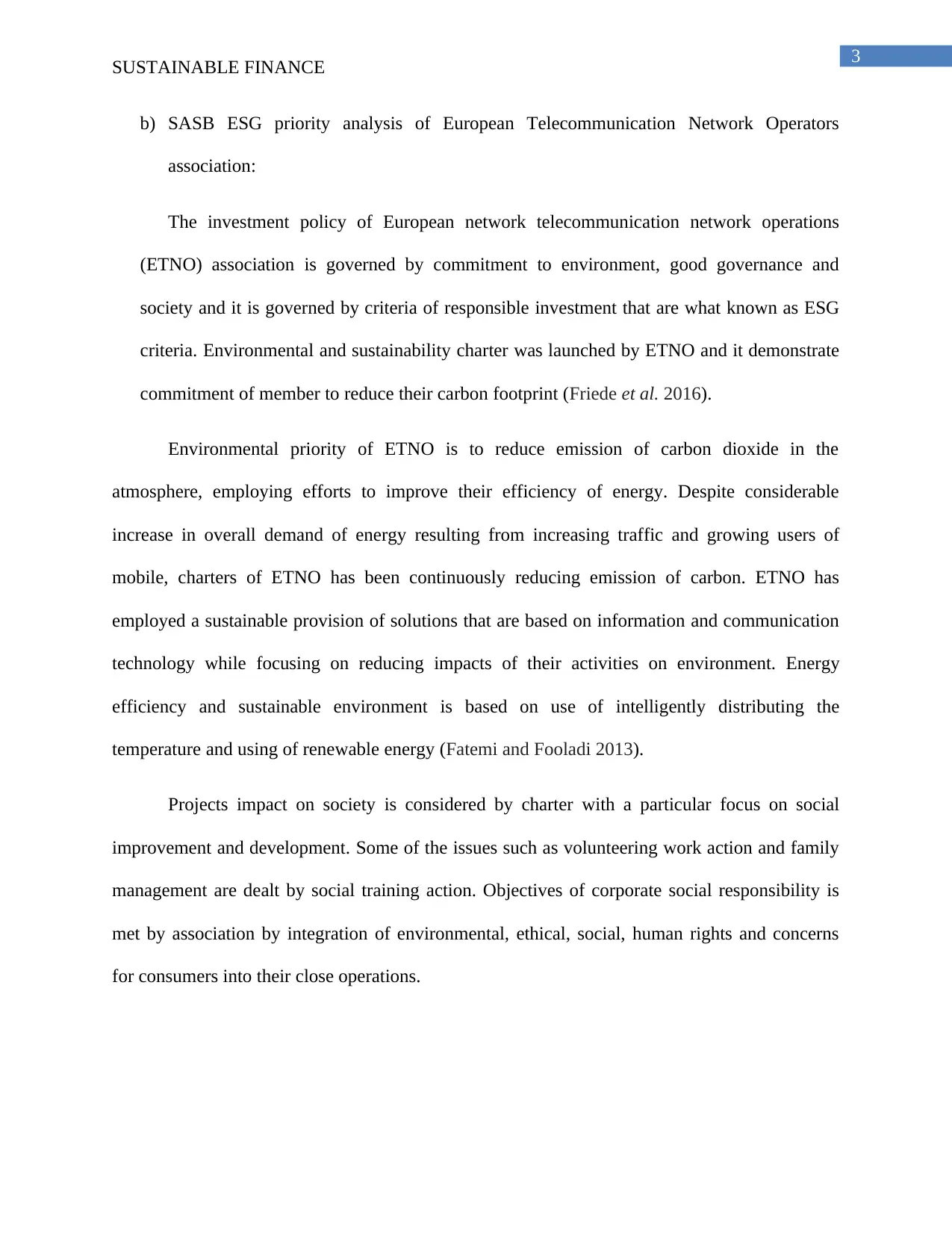
3
SUSTAINABLE FINANCE
b) SASB ESG priority analysis of European Telecommunication Network Operators
association:
The investment policy of European network telecommunication network operations
(ETNO) association is governed by commitment to environment, good governance and
society and it is governed by criteria of responsible investment that are what known as ESG
criteria. Environmental and sustainability charter was launched by ETNO and it demonstrate
commitment of member to reduce their carbon footprint (Friede et al. 2016).
Environmental priority of ETNO is to reduce emission of carbon dioxide in the
atmosphere, employing efforts to improve their efficiency of energy. Despite considerable
increase in overall demand of energy resulting from increasing traffic and growing users of
mobile, charters of ETNO has been continuously reducing emission of carbon. ETNO has
employed a sustainable provision of solutions that are based on information and communication
technology while focusing on reducing impacts of their activities on environment. Energy
efficiency and sustainable environment is based on use of intelligently distributing the
temperature and using of renewable energy (Fatemi and Fooladi 2013).
Projects impact on society is considered by charter with a particular focus on social
improvement and development. Some of the issues such as volunteering work action and family
management are dealt by social training action. Objectives of corporate social responsibility is
met by association by integration of environmental, ethical, social, human rights and concerns
for consumers into their close operations.
SUSTAINABLE FINANCE
b) SASB ESG priority analysis of European Telecommunication Network Operators
association:
The investment policy of European network telecommunication network operations
(ETNO) association is governed by commitment to environment, good governance and
society and it is governed by criteria of responsible investment that are what known as ESG
criteria. Environmental and sustainability charter was launched by ETNO and it demonstrate
commitment of member to reduce their carbon footprint (Friede et al. 2016).
Environmental priority of ETNO is to reduce emission of carbon dioxide in the
atmosphere, employing efforts to improve their efficiency of energy. Despite considerable
increase in overall demand of energy resulting from increasing traffic and growing users of
mobile, charters of ETNO has been continuously reducing emission of carbon. ETNO has
employed a sustainable provision of solutions that are based on information and communication
technology while focusing on reducing impacts of their activities on environment. Energy
efficiency and sustainable environment is based on use of intelligently distributing the
temperature and using of renewable energy (Fatemi and Fooladi 2013).
Projects impact on society is considered by charter with a particular focus on social
improvement and development. Some of the issues such as volunteering work action and family
management are dealt by social training action. Objectives of corporate social responsibility is
met by association by integration of environmental, ethical, social, human rights and concerns
for consumers into their close operations.
Paraphrase This Document
Need a fresh take? Get an instant paraphrase of this document with our AI Paraphraser
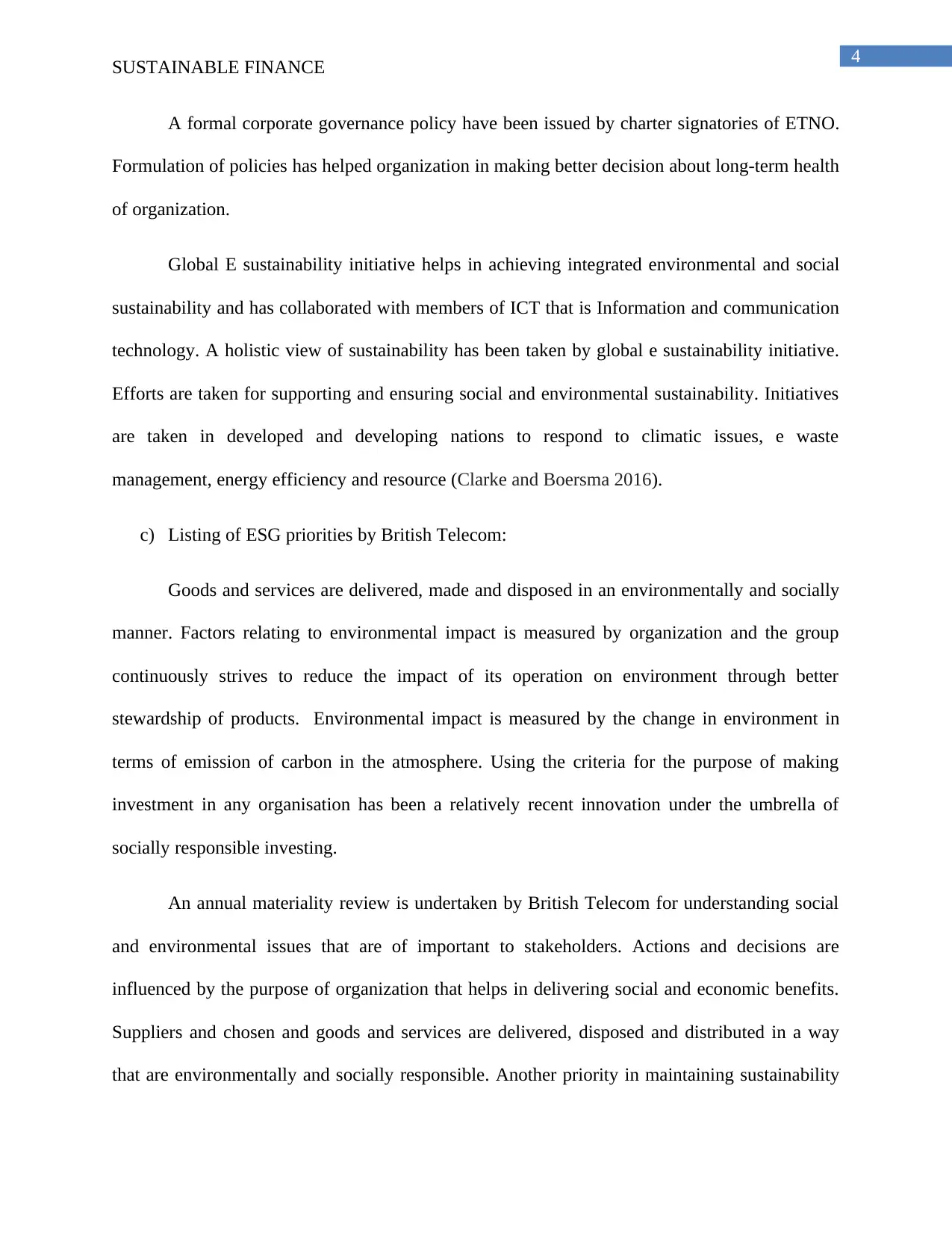
4
SUSTAINABLE FINANCE
A formal corporate governance policy have been issued by charter signatories of ETNO.
Formulation of policies has helped organization in making better decision about long-term health
of organization.
Global E sustainability initiative helps in achieving integrated environmental and social
sustainability and has collaborated with members of ICT that is Information and communication
technology. A holistic view of sustainability has been taken by global e sustainability initiative.
Efforts are taken for supporting and ensuring social and environmental sustainability. Initiatives
are taken in developed and developing nations to respond to climatic issues, e waste
management, energy efficiency and resource (Clarke and Boersma 2016).
c) Listing of ESG priorities by British Telecom:
Goods and services are delivered, made and disposed in an environmentally and socially
manner. Factors relating to environmental impact is measured by organization and the group
continuously strives to reduce the impact of its operation on environment through better
stewardship of products. Environmental impact is measured by the change in environment in
terms of emission of carbon in the atmosphere. Using the criteria for the purpose of making
investment in any organisation has been a relatively recent innovation under the umbrella of
socially responsible investing.
An annual materiality review is undertaken by British Telecom for understanding social
and environmental issues that are of important to stakeholders. Actions and decisions are
influenced by the purpose of organization that helps in delivering social and economic benefits.
Suppliers and chosen and goods and services are delivered, disposed and distributed in a way
that are environmentally and socially responsible. Another priority in maintaining sustainability
SUSTAINABLE FINANCE
A formal corporate governance policy have been issued by charter signatories of ETNO.
Formulation of policies has helped organization in making better decision about long-term health
of organization.
Global E sustainability initiative helps in achieving integrated environmental and social
sustainability and has collaborated with members of ICT that is Information and communication
technology. A holistic view of sustainability has been taken by global e sustainability initiative.
Efforts are taken for supporting and ensuring social and environmental sustainability. Initiatives
are taken in developed and developing nations to respond to climatic issues, e waste
management, energy efficiency and resource (Clarke and Boersma 2016).
c) Listing of ESG priorities by British Telecom:
Goods and services are delivered, made and disposed in an environmentally and socially
manner. Factors relating to environmental impact is measured by organization and the group
continuously strives to reduce the impact of its operation on environment through better
stewardship of products. Environmental impact is measured by the change in environment in
terms of emission of carbon in the atmosphere. Using the criteria for the purpose of making
investment in any organisation has been a relatively recent innovation under the umbrella of
socially responsible investing.
An annual materiality review is undertaken by British Telecom for understanding social
and environmental issues that are of important to stakeholders. Actions and decisions are
influenced by the purpose of organization that helps in delivering social and economic benefits.
Suppliers and chosen and goods and services are delivered, disposed and distributed in a way
that are environmentally and socially responsible. Another priority in maintaining sustainability
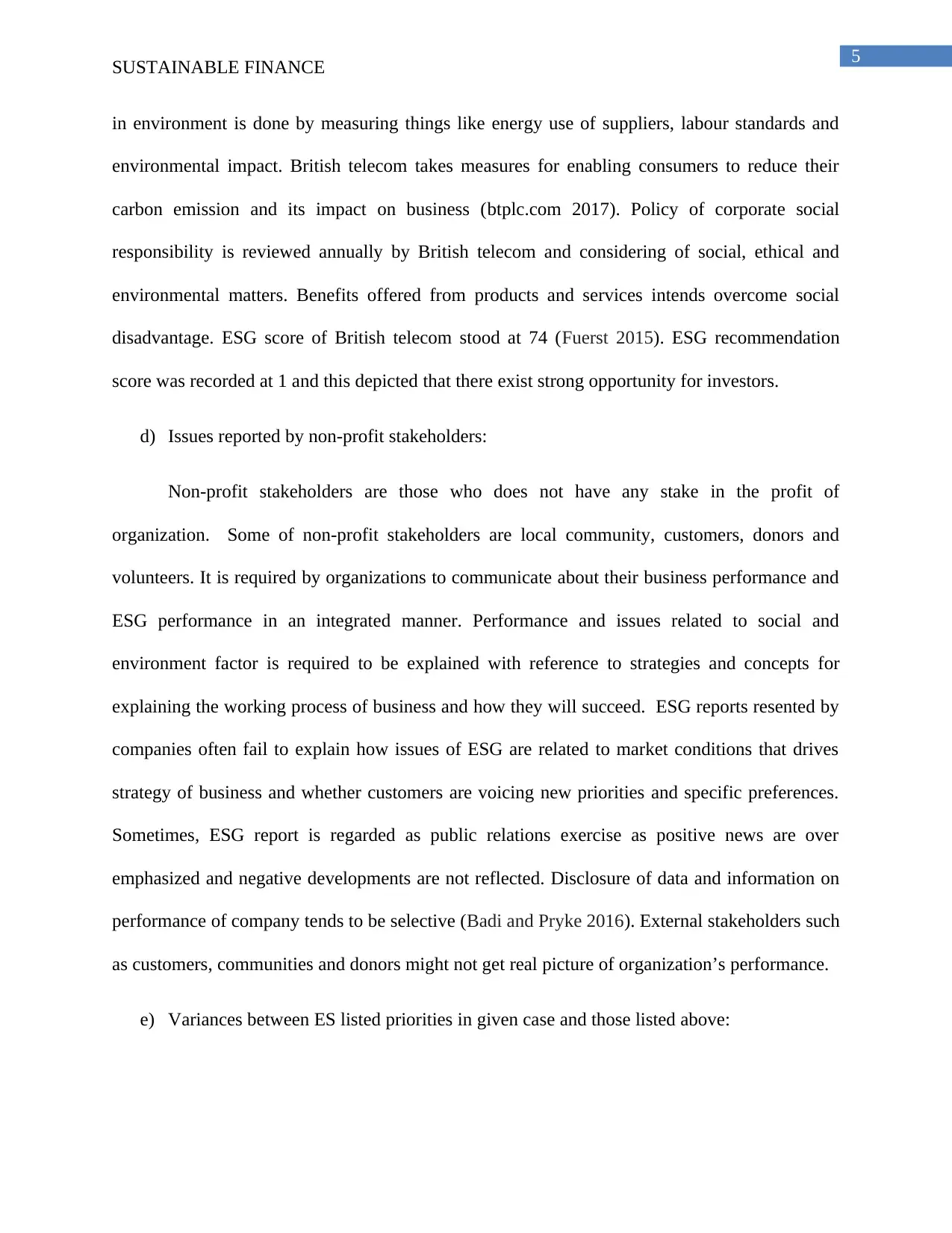
5
SUSTAINABLE FINANCE
in environment is done by measuring things like energy use of suppliers, labour standards and
environmental impact. British telecom takes measures for enabling consumers to reduce their
carbon emission and its impact on business (btplc.com 2017). Policy of corporate social
responsibility is reviewed annually by British telecom and considering of social, ethical and
environmental matters. Benefits offered from products and services intends overcome social
disadvantage. ESG score of British telecom stood at 74 (Fuerst 2015). ESG recommendation
score was recorded at 1 and this depicted that there exist strong opportunity for investors.
d) Issues reported by non-profit stakeholders:
Non-profit stakeholders are those who does not have any stake in the profit of
organization. Some of non-profit stakeholders are local community, customers, donors and
volunteers. It is required by organizations to communicate about their business performance and
ESG performance in an integrated manner. Performance and issues related to social and
environment factor is required to be explained with reference to strategies and concepts for
explaining the working process of business and how they will succeed. ESG reports resented by
companies often fail to explain how issues of ESG are related to market conditions that drives
strategy of business and whether customers are voicing new priorities and specific preferences.
Sometimes, ESG report is regarded as public relations exercise as positive news are over
emphasized and negative developments are not reflected. Disclosure of data and information on
performance of company tends to be selective (Badi and Pryke 2016). External stakeholders such
as customers, communities and donors might not get real picture of organization’s performance.
e) Variances between ES listed priorities in given case and those listed above:
SUSTAINABLE FINANCE
in environment is done by measuring things like energy use of suppliers, labour standards and
environmental impact. British telecom takes measures for enabling consumers to reduce their
carbon emission and its impact on business (btplc.com 2017). Policy of corporate social
responsibility is reviewed annually by British telecom and considering of social, ethical and
environmental matters. Benefits offered from products and services intends overcome social
disadvantage. ESG score of British telecom stood at 74 (Fuerst 2015). ESG recommendation
score was recorded at 1 and this depicted that there exist strong opportunity for investors.
d) Issues reported by non-profit stakeholders:
Non-profit stakeholders are those who does not have any stake in the profit of
organization. Some of non-profit stakeholders are local community, customers, donors and
volunteers. It is required by organizations to communicate about their business performance and
ESG performance in an integrated manner. Performance and issues related to social and
environment factor is required to be explained with reference to strategies and concepts for
explaining the working process of business and how they will succeed. ESG reports resented by
companies often fail to explain how issues of ESG are related to market conditions that drives
strategy of business and whether customers are voicing new priorities and specific preferences.
Sometimes, ESG report is regarded as public relations exercise as positive news are over
emphasized and negative developments are not reflected. Disclosure of data and information on
performance of company tends to be selective (Badi and Pryke 2016). External stakeholders such
as customers, communities and donors might not get real picture of organization’s performance.
e) Variances between ES listed priorities in given case and those listed above:
⊘ This is a preview!⊘
Do you want full access?
Subscribe today to unlock all pages.

Trusted by 1+ million students worldwide
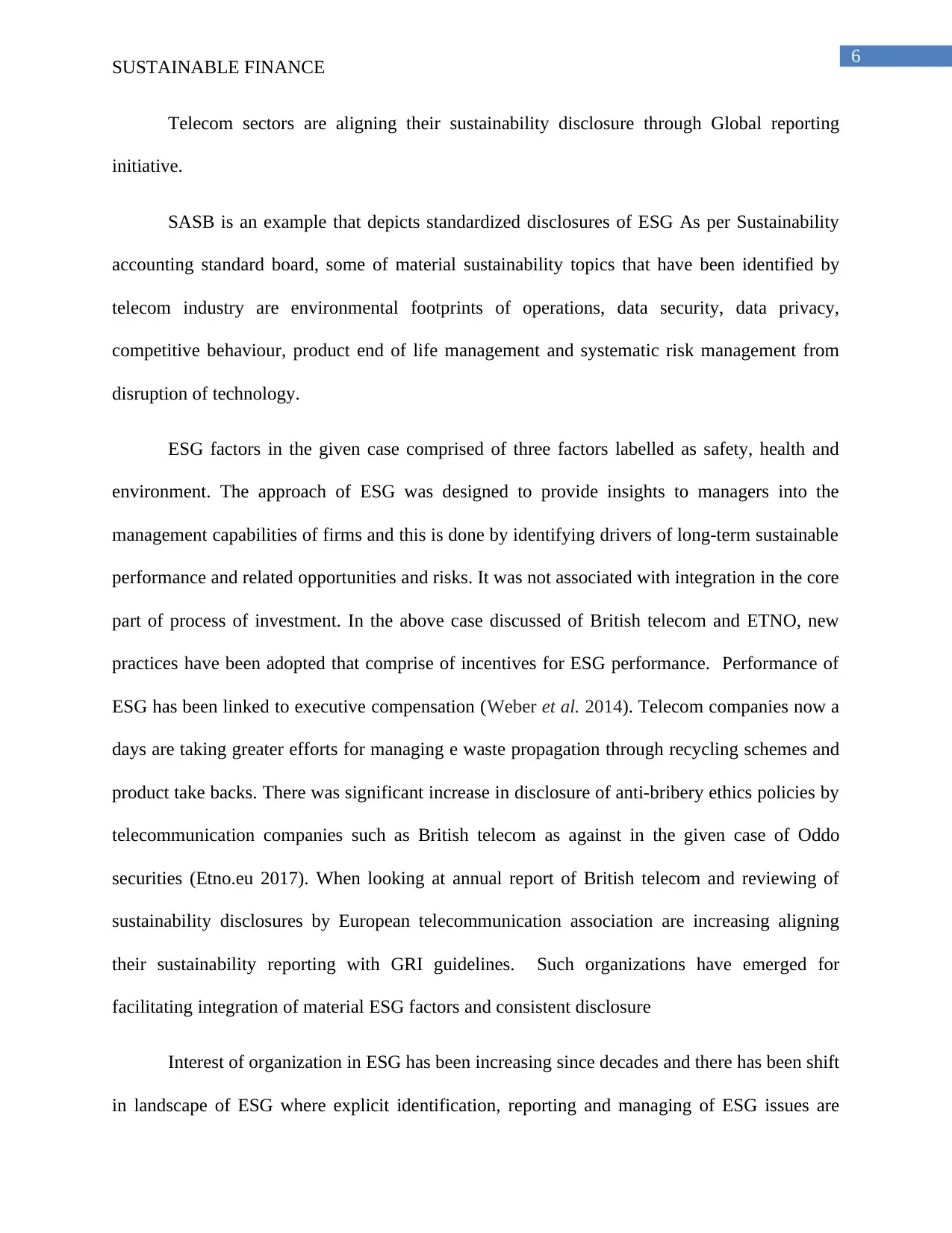
6
SUSTAINABLE FINANCE
Telecom sectors are aligning their sustainability disclosure through Global reporting
initiative.
SASB is an example that depicts standardized disclosures of ESG As per Sustainability
accounting standard board, some of material sustainability topics that have been identified by
telecom industry are environmental footprints of operations, data security, data privacy,
competitive behaviour, product end of life management and systematic risk management from
disruption of technology.
ESG factors in the given case comprised of three factors labelled as safety, health and
environment. The approach of ESG was designed to provide insights to managers into the
management capabilities of firms and this is done by identifying drivers of long-term sustainable
performance and related opportunities and risks. It was not associated with integration in the core
part of process of investment. In the above case discussed of British telecom and ETNO, new
practices have been adopted that comprise of incentives for ESG performance. Performance of
ESG has been linked to executive compensation (Weber et al. 2014). Telecom companies now a
days are taking greater efforts for managing e waste propagation through recycling schemes and
product take backs. There was significant increase in disclosure of anti-bribery ethics policies by
telecommunication companies such as British telecom as against in the given case of Oddo
securities (Etno.eu 2017). When looking at annual report of British telecom and reviewing of
sustainability disclosures by European telecommunication association are increasing aligning
their sustainability reporting with GRI guidelines. Such organizations have emerged for
facilitating integration of material ESG factors and consistent disclosure
Interest of organization in ESG has been increasing since decades and there has been shift
in landscape of ESG where explicit identification, reporting and managing of ESG issues are
SUSTAINABLE FINANCE
Telecom sectors are aligning their sustainability disclosure through Global reporting
initiative.
SASB is an example that depicts standardized disclosures of ESG As per Sustainability
accounting standard board, some of material sustainability topics that have been identified by
telecom industry are environmental footprints of operations, data security, data privacy,
competitive behaviour, product end of life management and systematic risk management from
disruption of technology.
ESG factors in the given case comprised of three factors labelled as safety, health and
environment. The approach of ESG was designed to provide insights to managers into the
management capabilities of firms and this is done by identifying drivers of long-term sustainable
performance and related opportunities and risks. It was not associated with integration in the core
part of process of investment. In the above case discussed of British telecom and ETNO, new
practices have been adopted that comprise of incentives for ESG performance. Performance of
ESG has been linked to executive compensation (Weber et al. 2014). Telecom companies now a
days are taking greater efforts for managing e waste propagation through recycling schemes and
product take backs. There was significant increase in disclosure of anti-bribery ethics policies by
telecommunication companies such as British telecom as against in the given case of Oddo
securities (Etno.eu 2017). When looking at annual report of British telecom and reviewing of
sustainability disclosures by European telecommunication association are increasing aligning
their sustainability reporting with GRI guidelines. Such organizations have emerged for
facilitating integration of material ESG factors and consistent disclosure
Interest of organization in ESG has been increasing since decades and there has been shift
in landscape of ESG where explicit identification, reporting and managing of ESG issues are
Paraphrase This Document
Need a fresh take? Get an instant paraphrase of this document with our AI Paraphraser
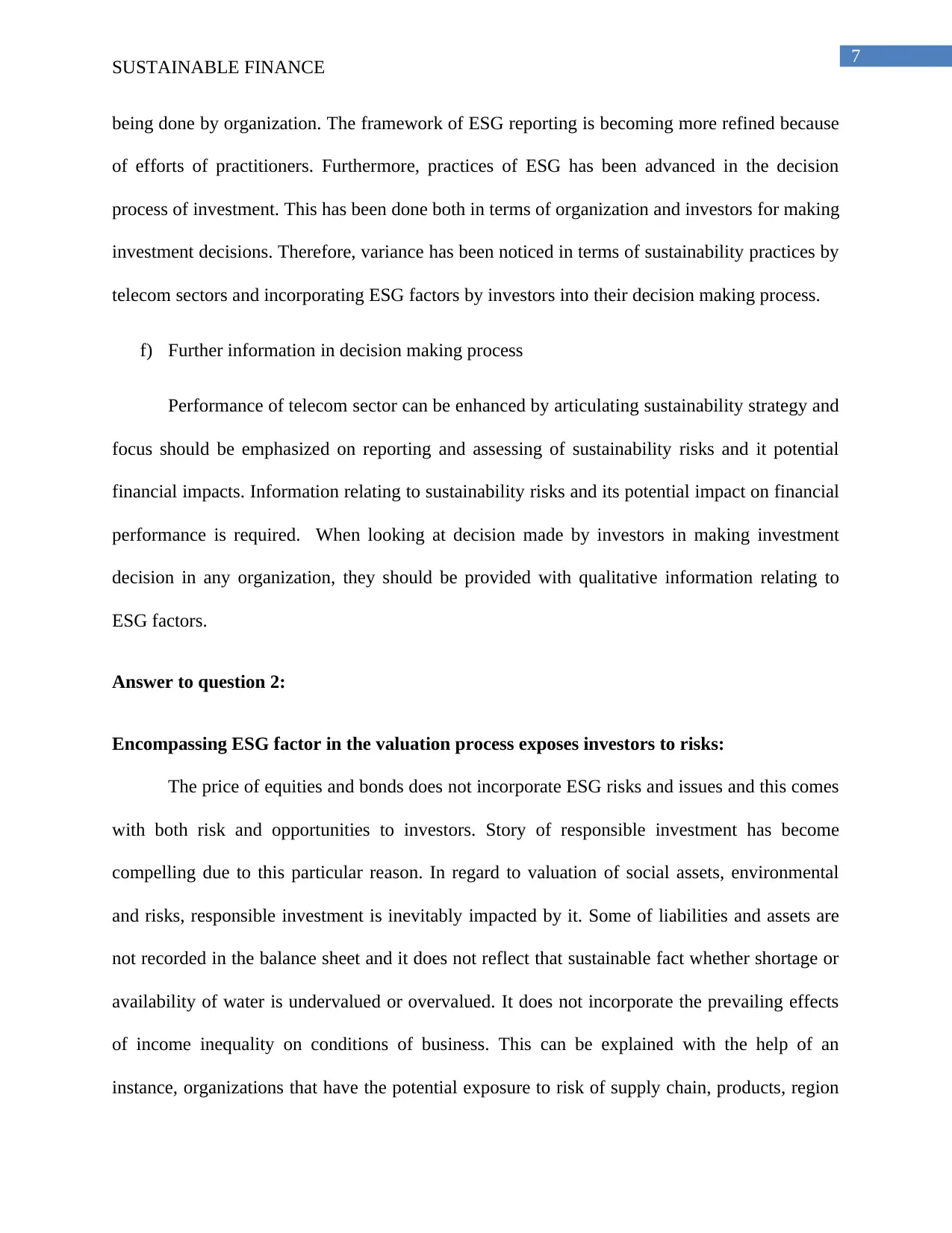
7
SUSTAINABLE FINANCE
being done by organization. The framework of ESG reporting is becoming more refined because
of efforts of practitioners. Furthermore, practices of ESG has been advanced in the decision
process of investment. This has been done both in terms of organization and investors for making
investment decisions. Therefore, variance has been noticed in terms of sustainability practices by
telecom sectors and incorporating ESG factors by investors into their decision making process.
f) Further information in decision making process
Performance of telecom sector can be enhanced by articulating sustainability strategy and
focus should be emphasized on reporting and assessing of sustainability risks and it potential
financial impacts. Information relating to sustainability risks and its potential impact on financial
performance is required. When looking at decision made by investors in making investment
decision in any organization, they should be provided with qualitative information relating to
ESG factors.
Answer to question 2:
Encompassing ESG factor in the valuation process exposes investors to risks:
The price of equities and bonds does not incorporate ESG risks and issues and this comes
with both risk and opportunities to investors. Story of responsible investment has become
compelling due to this particular reason. In regard to valuation of social assets, environmental
and risks, responsible investment is inevitably impacted by it. Some of liabilities and assets are
not recorded in the balance sheet and it does not reflect that sustainable fact whether shortage or
availability of water is undervalued or overvalued. It does not incorporate the prevailing effects
of income inequality on conditions of business. This can be explained with the help of an
instance, organizations that have the potential exposure to risk of supply chain, products, region
SUSTAINABLE FINANCE
being done by organization. The framework of ESG reporting is becoming more refined because
of efforts of practitioners. Furthermore, practices of ESG has been advanced in the decision
process of investment. This has been done both in terms of organization and investors for making
investment decisions. Therefore, variance has been noticed in terms of sustainability practices by
telecom sectors and incorporating ESG factors by investors into their decision making process.
f) Further information in decision making process
Performance of telecom sector can be enhanced by articulating sustainability strategy and
focus should be emphasized on reporting and assessing of sustainability risks and it potential
financial impacts. Information relating to sustainability risks and its potential impact on financial
performance is required. When looking at decision made by investors in making investment
decision in any organization, they should be provided with qualitative information relating to
ESG factors.
Answer to question 2:
Encompassing ESG factor in the valuation process exposes investors to risks:
The price of equities and bonds does not incorporate ESG risks and issues and this comes
with both risk and opportunities to investors. Story of responsible investment has become
compelling due to this particular reason. In regard to valuation of social assets, environmental
and risks, responsible investment is inevitably impacted by it. Some of liabilities and assets are
not recorded in the balance sheet and it does not reflect that sustainable fact whether shortage or
availability of water is undervalued or overvalued. It does not incorporate the prevailing effects
of income inequality on conditions of business. This can be explained with the help of an
instance, organizations that have the potential exposure to risk of supply chain, products, region
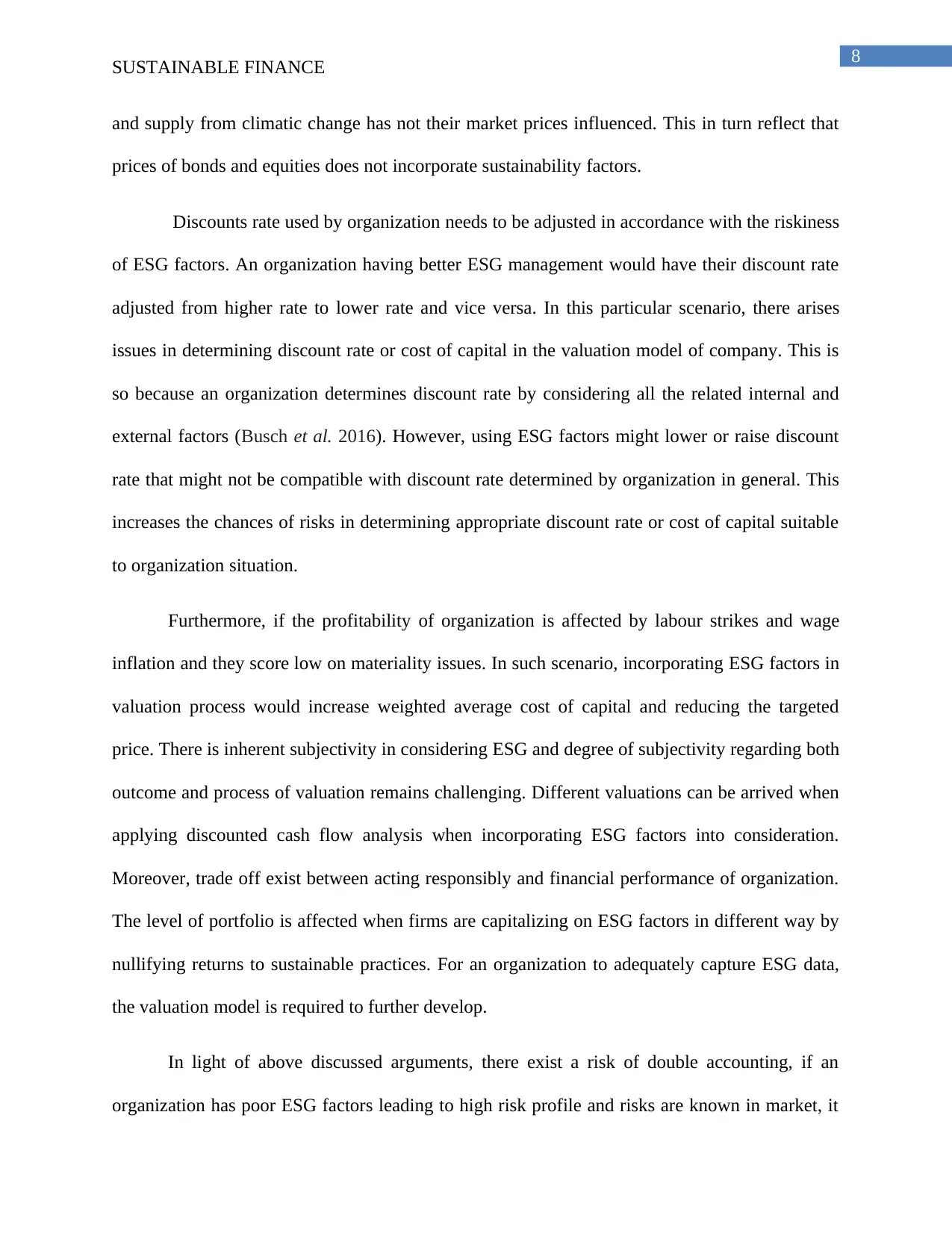
8
SUSTAINABLE FINANCE
and supply from climatic change has not their market prices influenced. This in turn reflect that
prices of bonds and equities does not incorporate sustainability factors.
Discounts rate used by organization needs to be adjusted in accordance with the riskiness
of ESG factors. An organization having better ESG management would have their discount rate
adjusted from higher rate to lower rate and vice versa. In this particular scenario, there arises
issues in determining discount rate or cost of capital in the valuation model of company. This is
so because an organization determines discount rate by considering all the related internal and
external factors (Busch et al. 2016). However, using ESG factors might lower or raise discount
rate that might not be compatible with discount rate determined by organization in general. This
increases the chances of risks in determining appropriate discount rate or cost of capital suitable
to organization situation.
Furthermore, if the profitability of organization is affected by labour strikes and wage
inflation and they score low on materiality issues. In such scenario, incorporating ESG factors in
valuation process would increase weighted average cost of capital and reducing the targeted
price. There is inherent subjectivity in considering ESG and degree of subjectivity regarding both
outcome and process of valuation remains challenging. Different valuations can be arrived when
applying discounted cash flow analysis when incorporating ESG factors into consideration.
Moreover, trade off exist between acting responsibly and financial performance of organization.
The level of portfolio is affected when firms are capitalizing on ESG factors in different way by
nullifying returns to sustainable practices. For an organization to adequately capture ESG data,
the valuation model is required to further develop.
In light of above discussed arguments, there exist a risk of double accounting, if an
organization has poor ESG factors leading to high risk profile and risks are known in market, it
SUSTAINABLE FINANCE
and supply from climatic change has not their market prices influenced. This in turn reflect that
prices of bonds and equities does not incorporate sustainability factors.
Discounts rate used by organization needs to be adjusted in accordance with the riskiness
of ESG factors. An organization having better ESG management would have their discount rate
adjusted from higher rate to lower rate and vice versa. In this particular scenario, there arises
issues in determining discount rate or cost of capital in the valuation model of company. This is
so because an organization determines discount rate by considering all the related internal and
external factors (Busch et al. 2016). However, using ESG factors might lower or raise discount
rate that might not be compatible with discount rate determined by organization in general. This
increases the chances of risks in determining appropriate discount rate or cost of capital suitable
to organization situation.
Furthermore, if the profitability of organization is affected by labour strikes and wage
inflation and they score low on materiality issues. In such scenario, incorporating ESG factors in
valuation process would increase weighted average cost of capital and reducing the targeted
price. There is inherent subjectivity in considering ESG and degree of subjectivity regarding both
outcome and process of valuation remains challenging. Different valuations can be arrived when
applying discounted cash flow analysis when incorporating ESG factors into consideration.
Moreover, trade off exist between acting responsibly and financial performance of organization.
The level of portfolio is affected when firms are capitalizing on ESG factors in different way by
nullifying returns to sustainable practices. For an organization to adequately capture ESG data,
the valuation model is required to further develop.
In light of above discussed arguments, there exist a risk of double accounting, if an
organization has poor ESG factors leading to high risk profile and risks are known in market, it
⊘ This is a preview!⊘
Do you want full access?
Subscribe today to unlock all pages.

Trusted by 1+ million students worldwide
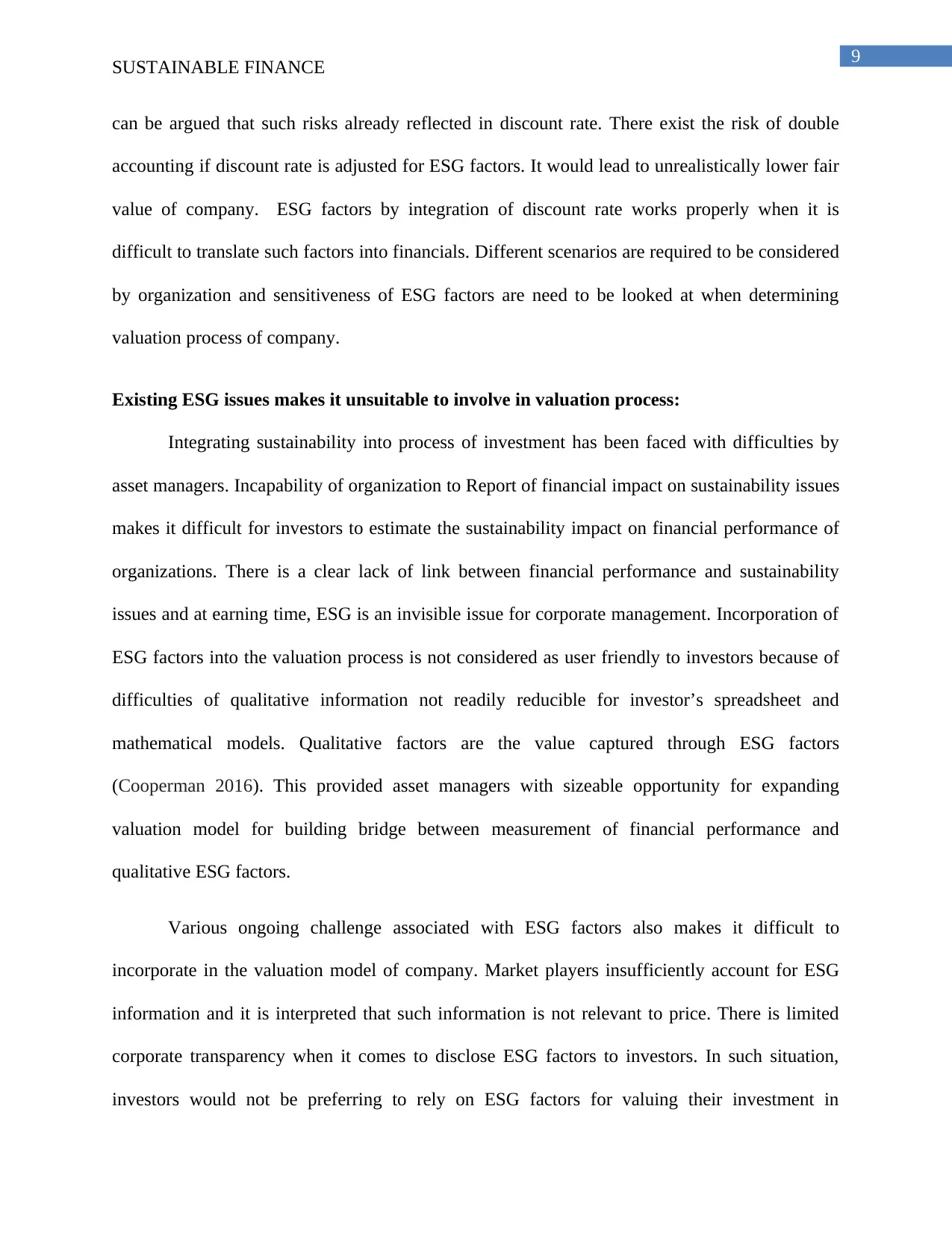
9
SUSTAINABLE FINANCE
can be argued that such risks already reflected in discount rate. There exist the risk of double
accounting if discount rate is adjusted for ESG factors. It would lead to unrealistically lower fair
value of company. ESG factors by integration of discount rate works properly when it is
difficult to translate such factors into financials. Different scenarios are required to be considered
by organization and sensitiveness of ESG factors are need to be looked at when determining
valuation process of company.
Existing ESG issues makes it unsuitable to involve in valuation process:
Integrating sustainability into process of investment has been faced with difficulties by
asset managers. Incapability of organization to Report of financial impact on sustainability issues
makes it difficult for investors to estimate the sustainability impact on financial performance of
organizations. There is a clear lack of link between financial performance and sustainability
issues and at earning time, ESG is an invisible issue for corporate management. Incorporation of
ESG factors into the valuation process is not considered as user friendly to investors because of
difficulties of qualitative information not readily reducible for investor’s spreadsheet and
mathematical models. Qualitative factors are the value captured through ESG factors
(Cooperman 2016). This provided asset managers with sizeable opportunity for expanding
valuation model for building bridge between measurement of financial performance and
qualitative ESG factors.
Various ongoing challenge associated with ESG factors also makes it difficult to
incorporate in the valuation model of company. Market players insufficiently account for ESG
information and it is interpreted that such information is not relevant to price. There is limited
corporate transparency when it comes to disclose ESG factors to investors. In such situation,
investors would not be preferring to rely on ESG factors for valuing their investment in
SUSTAINABLE FINANCE
can be argued that such risks already reflected in discount rate. There exist the risk of double
accounting if discount rate is adjusted for ESG factors. It would lead to unrealistically lower fair
value of company. ESG factors by integration of discount rate works properly when it is
difficult to translate such factors into financials. Different scenarios are required to be considered
by organization and sensitiveness of ESG factors are need to be looked at when determining
valuation process of company.
Existing ESG issues makes it unsuitable to involve in valuation process:
Integrating sustainability into process of investment has been faced with difficulties by
asset managers. Incapability of organization to Report of financial impact on sustainability issues
makes it difficult for investors to estimate the sustainability impact on financial performance of
organizations. There is a clear lack of link between financial performance and sustainability
issues and at earning time, ESG is an invisible issue for corporate management. Incorporation of
ESG factors into the valuation process is not considered as user friendly to investors because of
difficulties of qualitative information not readily reducible for investor’s spreadsheet and
mathematical models. Qualitative factors are the value captured through ESG factors
(Cooperman 2016). This provided asset managers with sizeable opportunity for expanding
valuation model for building bridge between measurement of financial performance and
qualitative ESG factors.
Various ongoing challenge associated with ESG factors also makes it difficult to
incorporate in the valuation model of company. Market players insufficiently account for ESG
information and it is interpreted that such information is not relevant to price. There is limited
corporate transparency when it comes to disclose ESG factors to investors. In such situation,
investors would not be preferring to rely on ESG factors for valuing their investment in
Paraphrase This Document
Need a fresh take? Get an instant paraphrase of this document with our AI Paraphraser
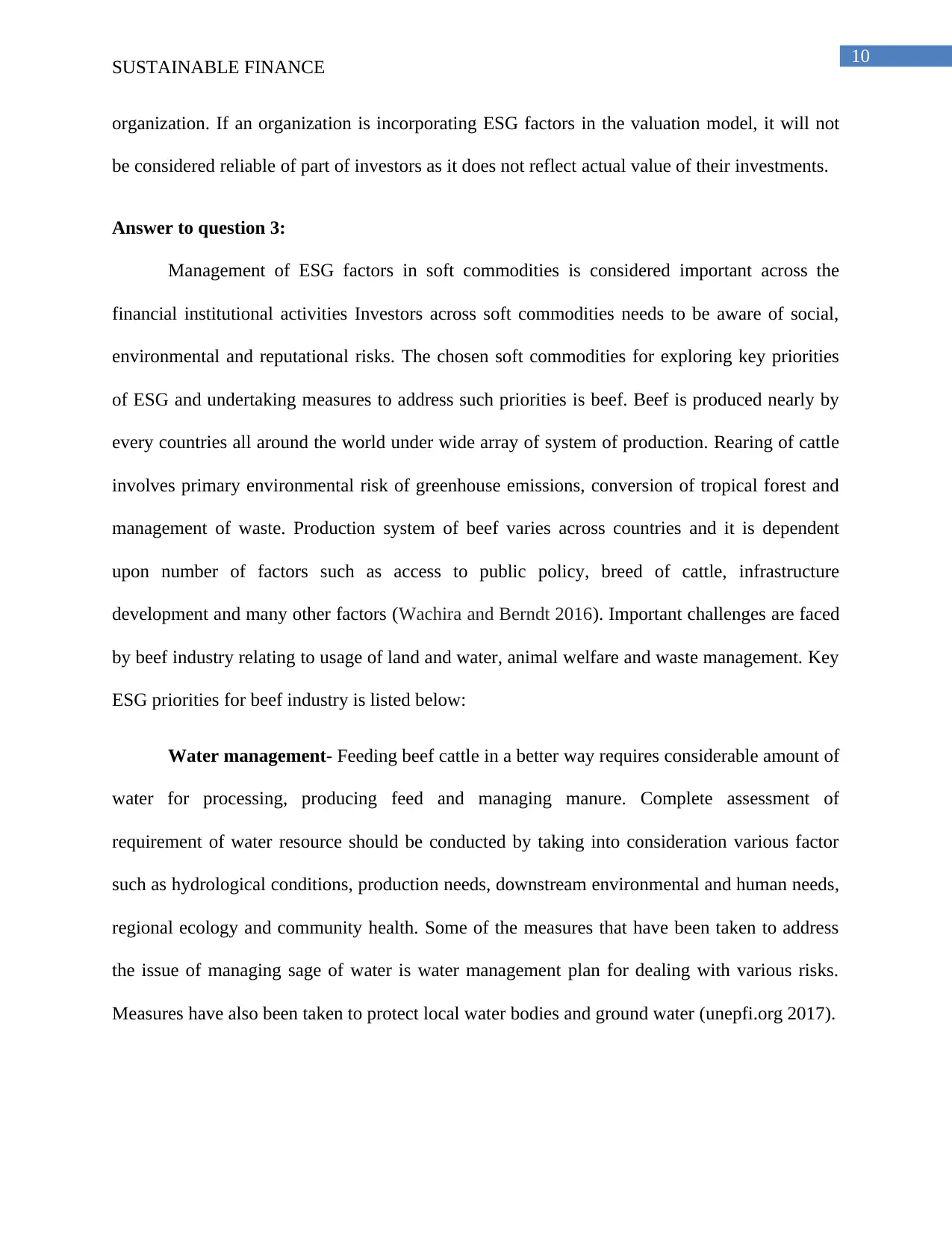
10
SUSTAINABLE FINANCE
organization. If an organization is incorporating ESG factors in the valuation model, it will not
be considered reliable of part of investors as it does not reflect actual value of their investments.
Answer to question 3:
Management of ESG factors in soft commodities is considered important across the
financial institutional activities Investors across soft commodities needs to be aware of social,
environmental and reputational risks. The chosen soft commodities for exploring key priorities
of ESG and undertaking measures to address such priorities is beef. Beef is produced nearly by
every countries all around the world under wide array of system of production. Rearing of cattle
involves primary environmental risk of greenhouse emissions, conversion of tropical forest and
management of waste. Production system of beef varies across countries and it is dependent
upon number of factors such as access to public policy, breed of cattle, infrastructure
development and many other factors (Wachira and Berndt 2016). Important challenges are faced
by beef industry relating to usage of land and water, animal welfare and waste management. Key
ESG priorities for beef industry is listed below:
Water management- Feeding beef cattle in a better way requires considerable amount of
water for processing, producing feed and managing manure. Complete assessment of
requirement of water resource should be conducted by taking into consideration various factor
such as hydrological conditions, production needs, downstream environmental and human needs,
regional ecology and community health. Some of the measures that have been taken to address
the issue of managing sage of water is water management plan for dealing with various risks.
Measures have also been taken to protect local water bodies and ground water (unepfi.org 2017).
SUSTAINABLE FINANCE
organization. If an organization is incorporating ESG factors in the valuation model, it will not
be considered reliable of part of investors as it does not reflect actual value of their investments.
Answer to question 3:
Management of ESG factors in soft commodities is considered important across the
financial institutional activities Investors across soft commodities needs to be aware of social,
environmental and reputational risks. The chosen soft commodities for exploring key priorities
of ESG and undertaking measures to address such priorities is beef. Beef is produced nearly by
every countries all around the world under wide array of system of production. Rearing of cattle
involves primary environmental risk of greenhouse emissions, conversion of tropical forest and
management of waste. Production system of beef varies across countries and it is dependent
upon number of factors such as access to public policy, breed of cattle, infrastructure
development and many other factors (Wachira and Berndt 2016). Important challenges are faced
by beef industry relating to usage of land and water, animal welfare and waste management. Key
ESG priorities for beef industry is listed below:
Water management- Feeding beef cattle in a better way requires considerable amount of
water for processing, producing feed and managing manure. Complete assessment of
requirement of water resource should be conducted by taking into consideration various factor
such as hydrological conditions, production needs, downstream environmental and human needs,
regional ecology and community health. Some of the measures that have been taken to address
the issue of managing sage of water is water management plan for dealing with various risks.
Measures have also been taken to protect local water bodies and ground water (unepfi.org 2017).
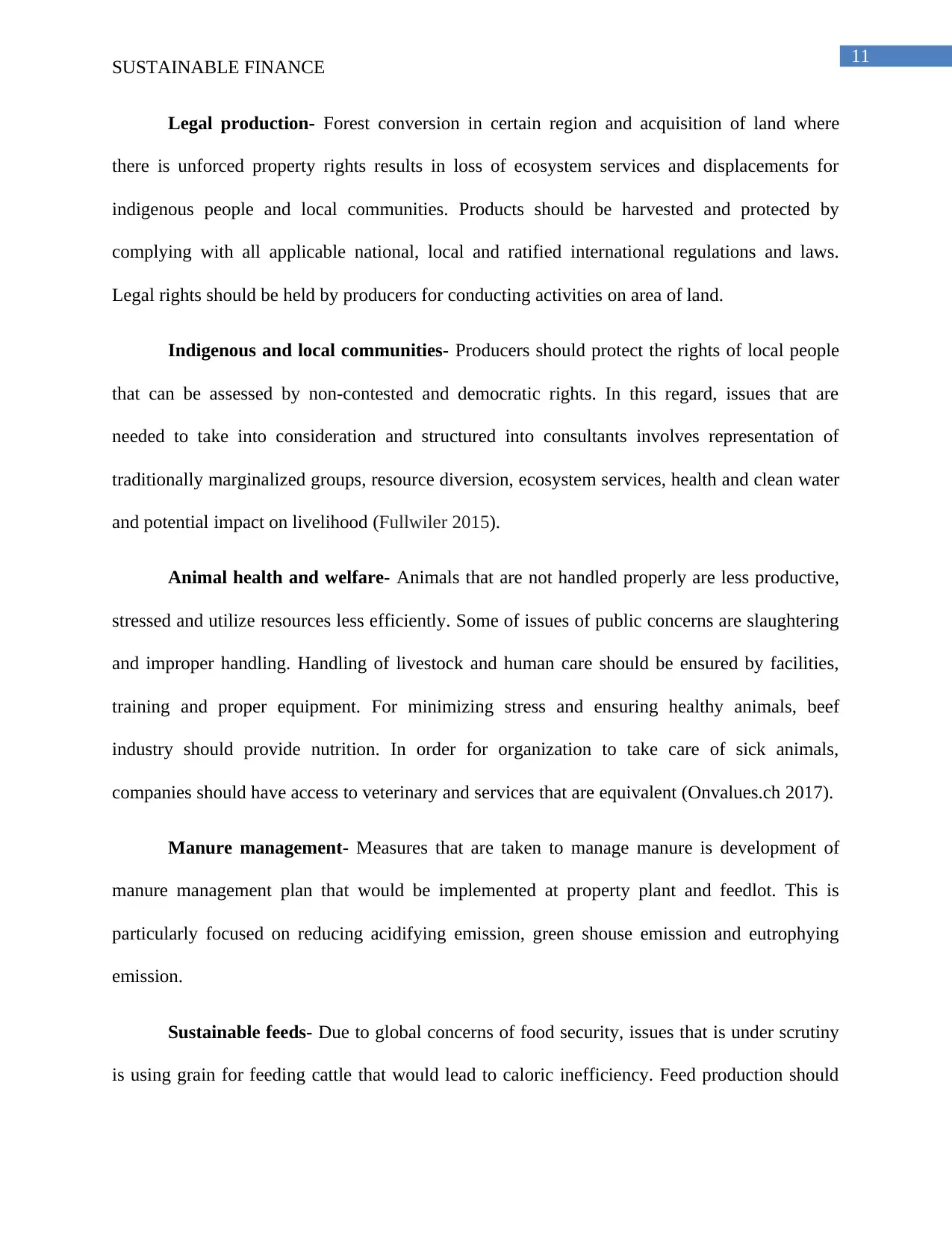
11
SUSTAINABLE FINANCE
Legal production- Forest conversion in certain region and acquisition of land where
there is unforced property rights results in loss of ecosystem services and displacements for
indigenous people and local communities. Products should be harvested and protected by
complying with all applicable national, local and ratified international regulations and laws.
Legal rights should be held by producers for conducting activities on area of land.
Indigenous and local communities- Producers should protect the rights of local people
that can be assessed by non-contested and democratic rights. In this regard, issues that are
needed to take into consideration and structured into consultants involves representation of
traditionally marginalized groups, resource diversion, ecosystem services, health and clean water
and potential impact on livelihood (Fullwiler 2015).
Animal health and welfare- Animals that are not handled properly are less productive,
stressed and utilize resources less efficiently. Some of issues of public concerns are slaughtering
and improper handling. Handling of livestock and human care should be ensured by facilities,
training and proper equipment. For minimizing stress and ensuring healthy animals, beef
industry should provide nutrition. In order for organization to take care of sick animals,
companies should have access to veterinary and services that are equivalent (Onvalues.ch 2017).
Manure management- Measures that are taken to manage manure is development of
manure management plan that would be implemented at property plant and feedlot. This is
particularly focused on reducing acidifying emission, green shouse emission and eutrophying
emission.
Sustainable feeds- Due to global concerns of food security, issues that is under scrutiny
is using grain for feeding cattle that would lead to caloric inefficiency. Feed production should
SUSTAINABLE FINANCE
Legal production- Forest conversion in certain region and acquisition of land where
there is unforced property rights results in loss of ecosystem services and displacements for
indigenous people and local communities. Products should be harvested and protected by
complying with all applicable national, local and ratified international regulations and laws.
Legal rights should be held by producers for conducting activities on area of land.
Indigenous and local communities- Producers should protect the rights of local people
that can be assessed by non-contested and democratic rights. In this regard, issues that are
needed to take into consideration and structured into consultants involves representation of
traditionally marginalized groups, resource diversion, ecosystem services, health and clean water
and potential impact on livelihood (Fullwiler 2015).
Animal health and welfare- Animals that are not handled properly are less productive,
stressed and utilize resources less efficiently. Some of issues of public concerns are slaughtering
and improper handling. Handling of livestock and human care should be ensured by facilities,
training and proper equipment. For minimizing stress and ensuring healthy animals, beef
industry should provide nutrition. In order for organization to take care of sick animals,
companies should have access to veterinary and services that are equivalent (Onvalues.ch 2017).
Manure management- Measures that are taken to manage manure is development of
manure management plan that would be implemented at property plant and feedlot. This is
particularly focused on reducing acidifying emission, green shouse emission and eutrophying
emission.
Sustainable feeds- Due to global concerns of food security, issues that is under scrutiny
is using grain for feeding cattle that would lead to caloric inefficiency. Feed production should
⊘ This is a preview!⊘
Do you want full access?
Subscribe today to unlock all pages.

Trusted by 1+ million students worldwide
1 out of 25
Related Documents
Your All-in-One AI-Powered Toolkit for Academic Success.
+13062052269
info@desklib.com
Available 24*7 on WhatsApp / Email
![[object Object]](/_next/static/media/star-bottom.7253800d.svg)
Unlock your academic potential
Copyright © 2020–2025 A2Z Services. All Rights Reserved. Developed and managed by ZUCOL.




